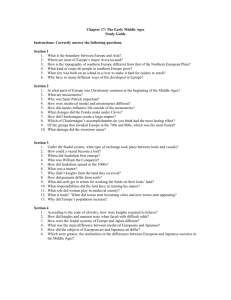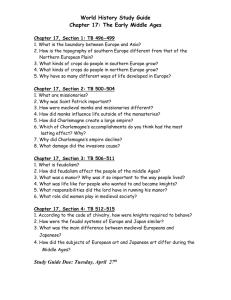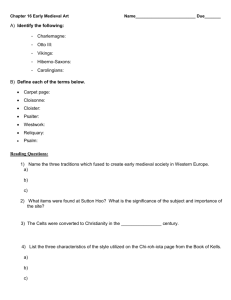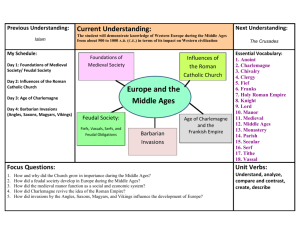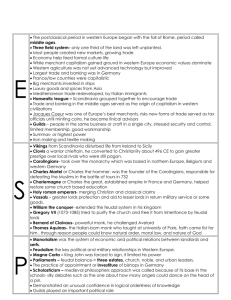The Early Middle Ages: The Feudal Spirit
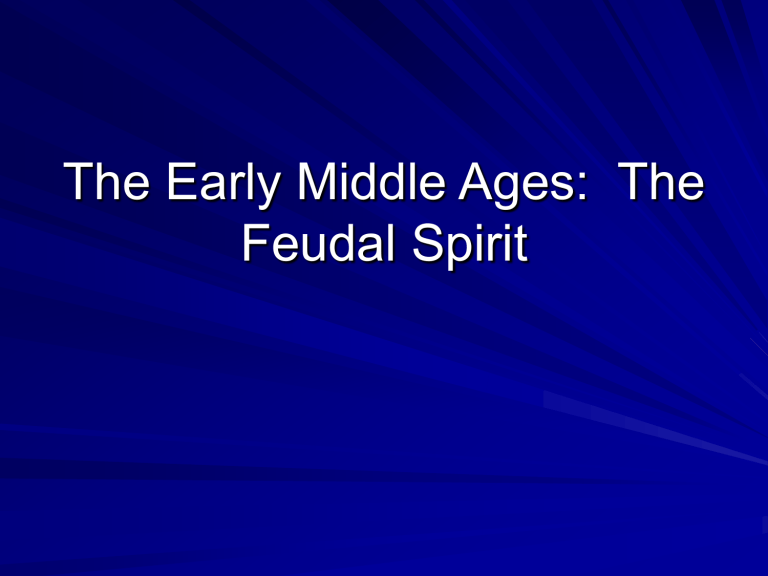
The Early Middle Ages: The
Feudal Spirit
The Age of Charlemagne
Descended from Franks: valued war and destruction
Blend of two cultures during reign of
Charlemagne
Kingdom: Large European kingdom, from the Rhine to Spain
Renewed interest in learning and arts
The Carolingian Renaissance
His interest in culture assembled group of scholars and artists. Favorite book: The
City of God
Imperial ideal from Rome and Byzantium
Monks copied manuscripts and painted, learned chants and interpreted the Bible.
Alcuin of York, teacher: revival of learning and literacy. Attempted universal education
The Culture of the Book
Books were expensive
Illustrated manuscripts: Hellenistic and
Byzantine style, incorporating Anglo-
Saxon art.
Utrecht Psalter: collection of Psalms
Sculpture disappeared. Reliquaries.
The cult of relics
Charlemagne’s Court
Pilgrimage to Rome in 800. Crowned emperor. First monarch since Roman times
Aachen, Aix-la-Chapelle. Modeled after
Byzantine churches
Charlemagne’s kingdom only lasted one generation after his death
New wave of invasions: Muslims,
Hungarians, Vikings
Feudal Europe
France and England brunt of Viking invasions
Decentralized system: feudal estates
Feudalism: system based on vows of military service and ownership of land.
Based on grant of lands by lords to vassals in return for service
Castle: residence of lords family
Refuge for the feudal estate during war
Crusaders came back and improved them
Fortresses to defend against siege
Decoration of castles simple tapestries to protect from cold
Pagan rituals and celebrations: mumming
Origin of masquerades and masked dances
The Song of Roland
Oral literature of military exploits such as epics.
Battle from Charlemagne’s campaigns in
Spain. Hero: Roland who battles Muslim knights
Celebrated knights’ bravery in battle and loyalty to his lord
No women
Tale of feudal courage, violence and treachery
Blows his horn to summon Charlemagne, but dies before king appears
Feudal and Christian values are highlighted
Chivalry
Emerged as a way to enforce loyalty.
Loyal to lord, not sleep with his wife, or surrender his castle as well as religious devotion and service to ladies
Tournaments: feasting, pageantry and dance
Professional warriors emerged
The Bayeux Tapestry
1066: Battle of Hastings William the
Conqueror’s victory over the English
Tapestry: Embroidered wall hanging recounting the chain of events. 231 feet long linen cloth. Probably embroidered by
English women.
Influenced by Trajan’s column
Muslim Spain
Cultivated society where Muslims, Jews and Christians coexisted.
Influence of architecture, poetry and philosophy
711 Muslims from North Africa conquer
Spain. Power declined after 1000
Sephardic Jews had centers of learning
Spaniards pushed back Muslims until
1492 they expelled the last from
Granada
Muslims and Jews forced to convert
Monasticism
Rules of chastity, poverty and obedience
Refuge from the barbarians
Centers of learning and
Evangelizing monks and cloistered monks
Guardians of arts and artifacts of Western civilization
Abbey of St. Gall in Switzerland (c. 820)
The Romanesque Style
Descendants of Otto the Great created
Romanesque style of architecture
Rounded Roman arches and barrel vaults
Massive vaults and piers and decoration
Abbey of Cluny in Burgundy, France
Some elements of the Gothic church
The Pilgrimage Churches
Medieval tourist centers; stopping points during pilgrimages to Santiago de
Compostela
St. Sernin Latin Cross floorplan) chapels off the apse transept( housed the relics) portals ambulatories
Romanesque Sculpture
Relief sculpture: Bibles in stone
Portal sculpture on the tympanum
Autun: Gislibertus’ lintel sculpture warning of wages of sin
Vezelay: relics of Mary Magdalene
Early Medieval Music and
Drama
Musical Notation. Initially, chants were taught by oral tradition
Guido d’Arezzo: six note scale and solmization: ut, re, mi, fa, sol, la, ti
Guidonian Hand
Staff: tone; Clef set the tone F or C
Invited to Vatican to teach
Sacred music passed down
Hildegard of Bingen
German abbess (1098-1179)
Composed mystical poetry and music
Morality play set to music
Women should use Mary as role model and reject Eve the sinner
Drama in the Medieval Church
Medieval theater: representations of
Christ’s birth death and resurrection
The Three Wise Men, Herod’s Slaughter of the Innocents, and the Raising of Lazarus.
Written in Latin; brief
Churchgoers followed the scenes throughout the church
Moved outside the church in the 13th cent.
Medieval Philosophy
Christian problems: existence of God, relationship between faith and reason
Cathedral schools fostered learning; translation of Aristotle’s works
Peter Abelard (1079-1142) Tragic love of
Heloise.
Sic et Non: exposed inconsistencies in
Church teachings
